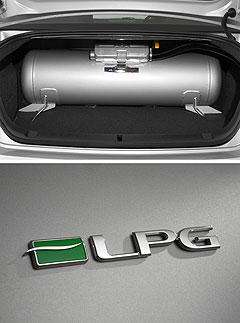News - General News - FuelsLPG interest spikesGas pumped: LPG is in favour in Queensland where the price of petrol is set to jump about 10 per cent. Looming federal LPG subsidy cut and Queensland fuel subsidy demise trigger LPG rush9 Jun 2009 QUEENSLAND LPG vehicle converters have experienced a rush of customer inquiries in the lead-up to the axing of the state’s eight-cent fuel subsidy and the reduction in the federal government’s LPG vehicle scheme from July 1. Sunshine state motorists are bracing for fuel bill hikes of up to 10 per cent in the wake of premier Anna Bligh’s decision to cut the state’s 8.3-cent fuel subsidy in just three weeks. Ms Bligh said the move follows a NSW government decision to abolish a similar fuel subsidy in northern NSW from July 1, and that the measure would save the Queensland government $600 million a year. In a double-whammy for Queensland drivers that has also spiked interest in LPG vehicle conversions, the Rudd government’s May budget included a decision to reduce the federal LPG subsidy from $2000 to $1750. It will reduce further on June 1, 2010, to $1500, before falling to $1250 in July 2011 and $1000 in July 2012. The LPG conversion subsidy, introduced by the Howard government in August 2006, is scheduled to end of June 30, 2014, but there are no changes to the $2000 subsidy for new vehicles with factory-fitted LPG systems ($1000 for vehicles bought before November 10, 2008).  Left: Holden Commodore LPG Omega. Left: Holden Commodore LPG Omega.To April 2009, 216,191 vehicles had taken advantage of the LPG subsidy, consuming government grants totalling $31 million, but May budget papers reveal the shift from petrol to LPG will reduce government revenue by almost $84 million over the next five years, leading to a desire by treasury to “manage expenditure over the life of the program”. Federal budget documents indicate the reduced LPG subsidy is aimed at reducing the consumption of LPG, which unlike diesel and petrol is not taxed by the federal government. That will change on July 1, 2011, when excise of 2.5 cents per litre will be levied on all automotive LPG, increasing to five cents in July 2012, 7.5 cents in July 2013, 10 cents in July 2014 and, finally, 12.5 cents in July 2015. According to budget papers: “This measure results in a reduction in excise revenue of $83.9 million over five years (including $14 million in 2013-14) because LPG displaces other fully-excisable fuels.” The Rudd government’s May budget granted petrol a three-year reprieve from the Carbon Pollution Reduction Scheme, which targets a 25 per cent reduction in overall carbon emissions by 2020 but has been delayed until 2011, partly because the transport sector produces just 13.5 per cent of Australia’s greenhouse gases. While petrol will be exempt from the government’s emissions trading scheme until at least 2014, it remains subject to federal excise of 38.14 cents a litre, including 3.8 cents GST. LPG Australia said motorists were “puzzled why the government would strike against LPG, which cuts greenhouse gas emissions by at least 10 per cent, and puts out half the air pollutants of petrol and 95 per cent less than diesel”. It said last year, 125,000 extra vehicles were converted to run on Autogas, which is generally around half the price of petrol, saving more than 100,000 tonnes of CO2 being released into the atmosphere. “In the medium term, it is extremely difficult for any other vehicle fuel alternative to match these emissions savings on existing vehicles,” the spokesman said. “This is a blow to the industry and the installers who have invested in LPG.” Proponents of LPG say the government is short-sighted for not promoting Autogas as a substitute for imported oil since Australia is self-sufficient in LPG, but the Victorian Automobile Chamber of Commerce (VACC) welcomed what it described as the Rudd government’s continued endorsement of LPG. “We consider this to be good news,” said VACC chief David Purchase. “It means the conversion rebate, while reduced, will continue. It means $2000 is still available right now and the incentive will continue for motorists to convert vehicles to LPG. “Given that Australia is in the grip of what the treasurer described as ‘the worst of economic times’, he may have been tempted to target LPG conversions, reduce the rebate further or remove it completely. But the fact that he did not is a huge positive and an indicator that the government values LPG as an alternative fuel. “Australian LPG converters will be heartened by the news. They can now continue to trade with certainty, particularly in Victoria, which accounts for just over 50 per cent of installations and has more than 600 registered LPG conversion businesses. “Australia is virtually self sufficient in LPG with huge national reserves. There is an estimated three million tones of LPG produced by this country annually with supply not forecast to outstrip demand until at least 2030. “Therefore, together with the government’s commitment to the conversion rebate, LPG continues to remains a viable and attractive alternative option for those who wish to convert to a cheaper alternative fuel,” Mr Purchase said. The Society of Automotive Engineers Australasia (SAE-A) will host the Gaseous Fuels Technology Conference 2009 in Melbourne next Monday (June 15), when Australian industry experts will discuss the latest technologies, resources and challenges facing LPG, CNG, LNG and hydrogen. Conference organisers will highlight the fact that although Australia has an abundance of gaseous fuels, they supply only a small portion of the nation’s fuel needs. “The country's gaseous fuels are exported aggressively, while it imports crude oil to process as transport fuels,” says the SAE-A. “The conference premise is that gaseous fuels offer the best opportunity to provide diversity, certainty and competitive advantage for Australia's transport sector.” Read more:LPG grants to be phased out |
Click to shareGeneral News articlesResearch General News Motor industry news |














Facebook Twitter Instagram